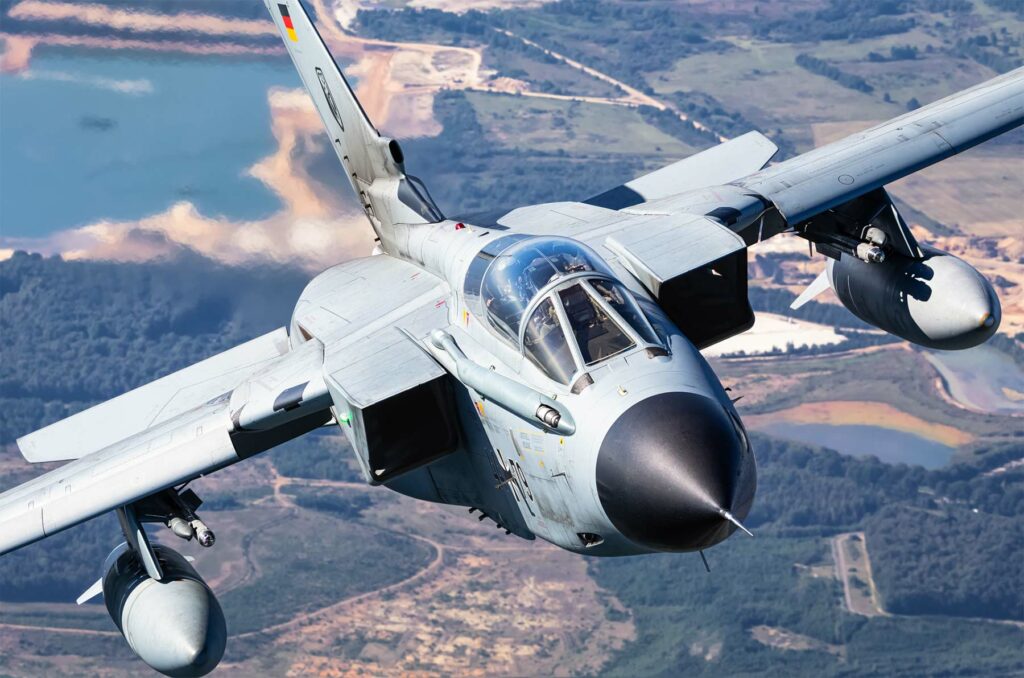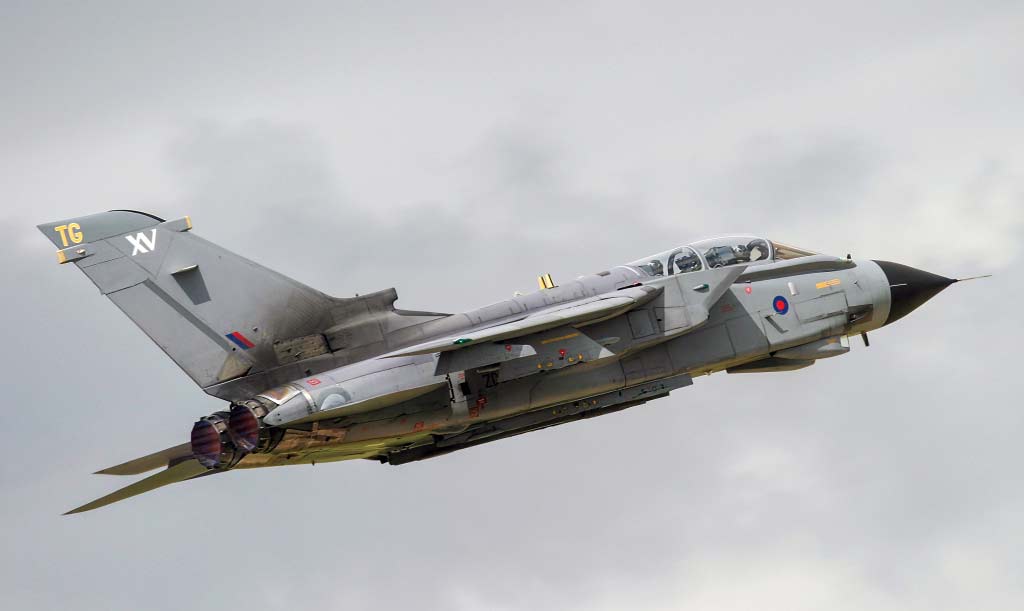The Panavia Tornado IDS is a twin-engine, variable-sweep wing multirole combat aircraft, adept in low-level penetration at high speeds.
In brief
The Tornado IDS (Interdictor/Strike) is engineered for all-weather, low-level strike missions. It is powered by two Turbo-Union RB199 turbofan engines, enabling supersonic speeds. With variable-sweep wings, the aircraft adapts aerodynamically for optimal performance across a broad range of speeds and altitudes. Equipped with sophisticated avionics and capable of carrying a diverse arsenal including air-to-ground and air-to-air weapons, the Tornado IDS is designed for deep penetration strike and interdiction missions.

History of the Development of the Panavia Tornado IDS
Developed during the Cold War, the Panavia Tornado was born from a collaboration between the UK, Germany, and Italy, initially conceptualized in the 1960s to replace older aircraft with a multirole combat aircraft capable of performing various missions with a single platform. The development was a response to the diverse tactical demands and the need for a robust strike capability against ground targets while retaining defensive capabilities against aerial threats. The MRCA (Multi-Role Combat Aircraft) program officially led to the establishment of Panavia Aircraft GmbH on March 29, 1969. The first prototype of the Tornado flew on August 14, 1974, marking the beginning of a new era for European military aviation.
Design of the Panavia Tornado IDS
The Tornado IDS features a distinctive variable-sweep wing design, allowing the aircraft to perform optimally at different speeds and mission profiles. Its twin-engine configuration ensures it can reach speeds of up to Mach 2.2. The aircraft’s structure incorporates durable materials capable of withstanding the stress of low-level flight at high speeds. The avionics suite includes terrain-following radar and a comprehensive electronic warfare system to enhance survivability and mission effectiveness. The design also supports in-flight refueling, extending its operational range and endurance.
Performance of the Panavia Tornado IDS
The Tornado IDS is powered by two Turbo-Union RB199 engines, producing a thrust sufficient to reach high supersonic speeds and a service ceiling of 50,000 feet. It can carry a vast range of munitions on its multiple hardpoints, enhanced by its variable geometry wings which maintain weapon alignment regardless of wing configuration. The aircraft’s sophisticated navigation and attack systems enable it to engage ground targets effectively even in adverse weather conditions, making it a formidable platform in tactical strike missions.
Variants of the Panavia Tornado IDS
The Tornado platform includes several variants tailored for specific roles:
- Tornado ECR (Electronic Combat/Reconnaissance): Specializes in SEAD (Suppression of Enemy Air Defenses) missions.
- Tornado ADV (Air Defence Variant): Focuses on interceptor roles with advanced radar and air-to-air missiles.
- The IDS model itself has seen upgrades to enhance its capabilities, including the GR4 in the UK, which features modernized avionics and weapons systems.

Military Use and Combat of the Panavia Tornado IDS
The Panavia Tornado IDS (Interdictor/Strike) has been extensively utilized by several air forces in a variety of conflict settings, demonstrating its robust capabilities in precision strike missions.
Gulf War (1990-1991): During Operation Desert Storm, the Tornado IDS was one of the primary aircraft used by the Royal Air Force and the Italian Air Force for deep penetration strikes. Its missions typically involved suppressing enemy air defenses and hitting strategic targets deep within enemy territory. The Tornado’s ability to fly at low levels and at high speeds made it particularly effective in evading radar detection and attacking airfields, command centers, and communication lines.
Kosovo War (1999): In Operation Allied Force, Tornado aircraft were used for air interdiction missions to disrupt Yugoslav military operations and infrastructure. They carried out strikes against strategic targets, utilizing their advanced targeting systems to deliver laser-guided bombs accurately.
Operations in Afghanistan (2001 onwards): Tornado IDS aircraft provided close air support to NATO ground forces fighting Taliban insurgents. Equipped with precision-guided munitions and reconnaissance capabilities, they played a crucial role in surveillance and ground support missions, often in rugged terrain and under challenging conditions.
Iraq War (2003-2011): Tornado GR4s, an upgraded version of the IDS, were heavily involved in the initial stages and subsequent operations in Iraq. They conducted numerous strikes on government and military installations, supporting coalition ground troops and contributing significantly to the coalition’s air superiority and ground support efforts.
Throughout these conflicts, the Tornado’s design allowed for effective deployment of a wide range of weaponry, tailored to various mission requirements. Its ongoing upgrades, including enhancements in avionics, weaponry, and defensive systems, have kept it effective against modern threats, maintaining its operational relevance in modern combat scenarios despite the aircraft’s age.
These operational histories highlight the Tornado’s adaptability and durability as a combat aircraft, capable of performing under the pressure of sophisticated air defense systems and modern electronic warfare environments. Its service with the air forces of Germany, Italy, Saudi Arabia, and the United Kingdom underscores the platform’s versatility and the high regard in which it is held across different nations.
The Panavia Tornado IDS remains a pivotal component of NATO’s tactical air forces, offering a unique combination of speed, versatility, and payload capacity to meet various operational demands. Its design and continuous updates ensure that it remains effective against evolving threats in contemporary warfare scenarios.
Back to the Fighter Jet section.